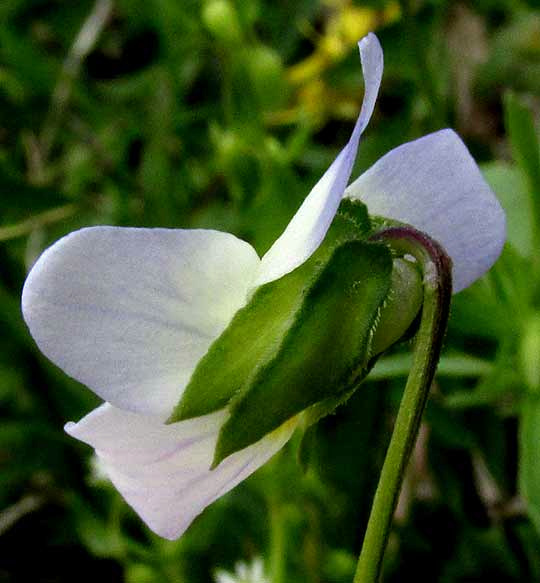Excerpts from Jim Conrad's
Naturalist Newsletter

from the April 19, 2015 Newsletter issued from Calhoun, McLean County, Kentucky, USA
FIELD PANSIES
Along weedy roadsides in our area, one of the most common wildflowers blooming nowadays is the one shown above. Notice that the flowers are "bilaterally symmetrical," meaning that there's only one way the corolla can be cut down the middle so that each half is a mirror image of the other. In the above picture you can most easily visualize where the bilateral cut would be on the corolla at the lower right. A close-up of one of the plant's flowers is shown below:

There you can see how nicely this blossom is adapted for pollinators. A small bee species can land on the expanded lower lip. The lip is marked with dark lines called "nectar guides" leading into the flower's throat, and the throat is yellow, highlighting it as a destination.
And important field mark for this species is that at the base of its slender leaves there appear deeply lobed, ear-like modified leaves known as stipules, shown below:

This is the Field Pansy, also called Wild Pansy or Johnny Jump-up. It's VIOLA BICOLOR*, distributed in weedy areas throughout North America, though less common or missing in much of the drier western states.
When I was a kid my father taught me to call Wild Pansies "Rooster Fighters," and below you can see the feature that in our culture made them "fighters":

Notice how the flower stem, or peduncle, curves at its top, with one side of the flower's calyx filling most of the space inside the curve. My father taught me how to hook two Field Pansy flowering heads together so that the crook of one peduncle fit into the crook of the other. Then the peduncles would be quickly jerked apart, resulting in the weaker peduncle losing its flower. The person holding the peduncle that still bore a flower was the winner, and that was a rooster fight.
All violet species can be used raw in salads or cooked like spinach. Their flowers can be eaten raw, or candied, and their dried leaves can be used for making tea. Violets can also be added to soups as a thickener.